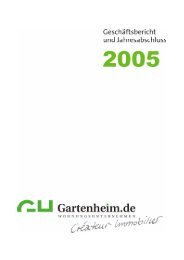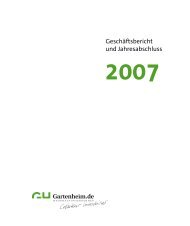analysis of the influences of solar radiation and façade glazing ...
analysis of the influences of solar radiation and façade glazing ...
analysis of the influences of solar radiation and façade glazing ...
You also want an ePaper? Increase the reach of your titles
YUMPU automatically turns print PDFs into web optimized ePapers that Google loves.
3.1 Building description 55<br />
All internal walls received a special kind <strong>of</strong> machine-sprayed plaster with an average<br />
thickness <strong>of</strong> 1.5 cm, which contains a high part <strong>of</strong> crushed clay. The feeling <strong>and</strong> <strong>the</strong><br />
biological data <strong>of</strong> <strong>the</strong> inside plaster is very similar to loam rendering. The external walls<br />
got a mineral render with a thickness <strong>of</strong> 2 – 3 cm, which is very permeable for vapor<br />
diffusion.<br />
Windows<br />
The type <strong>of</strong> <strong>glazing</strong> materials used in building construction makes a significant<br />
contribution to <strong>the</strong> annual energy consumption. For this reason, it was decided to examine<br />
twelve cases <strong>of</strong> fenestration products. The <strong>glazing</strong> systems in Case A1/B1 <strong>and</strong> Case A2/B2<br />
with low-e coatings are recommended for regions with cold climates. Low <strong>solar</strong> heat gains<br />
<strong>and</strong> high reflectivity are characteristic for windows in Case A5/B5 <strong>and</strong> Case A6/B6. This<br />
type <strong>of</strong> product is a very good choice for fully air-conditioned living spaces. Meanwhile<br />
<strong>glazing</strong> systems in Case A3/B3 <strong>and</strong> Case A4/B4 are designed for maximizing heat gain<br />
throughout <strong>the</strong> heating period <strong>and</strong> for reducing cooling costs during summer months.<br />
It is planned to use double glazed balcony windows (cases marked with letter A) <strong>and</strong> triple<strong>glazing</strong><br />
system for north <strong>and</strong> east elevation windows (cases marked with letter B).<br />
For all cases, it is decided to choose Xenon gas-fill on account <strong>of</strong> <strong>the</strong> best <strong>the</strong>rmal<br />
insulation properties, which are <strong>the</strong> result <strong>of</strong> very low effective conductivity equal to<br />
0.00516 W/mK.<br />
Thermal <strong>and</strong> optical properties depend on <strong>the</strong> location <strong>of</strong> coatings. Therefore, different<br />
configurations <strong>of</strong> optical filters on a glass surface are analyzed as shown in Fig. 3.5.<br />
outboard glass<br />
gas<br />
inboard glass<br />
filter location<br />
Case A1,3,5 Case A2,4,6<br />
Fig. 3.5: Location <strong>of</strong> a glass coating for <strong>the</strong> investigated cases.<br />
outboard glass<br />
gas<br />
inboard glass<br />
outboard glass<br />
Table 3.3 shows <strong>the</strong> detailed characteristics <strong>of</strong> <strong>the</strong> proposed <strong>glazing</strong> systems, which are<br />
prepared based on <strong>the</strong> publicly available International Glazing Database (IGDB) (2008).<br />
gas<br />
internal glass<br />
filter location<br />
gas<br />
inboard glass<br />
outboard glass<br />
gas<br />
internal glass<br />
gas<br />
Case B1,3,5 Case B2,4,6<br />
inboard glass





